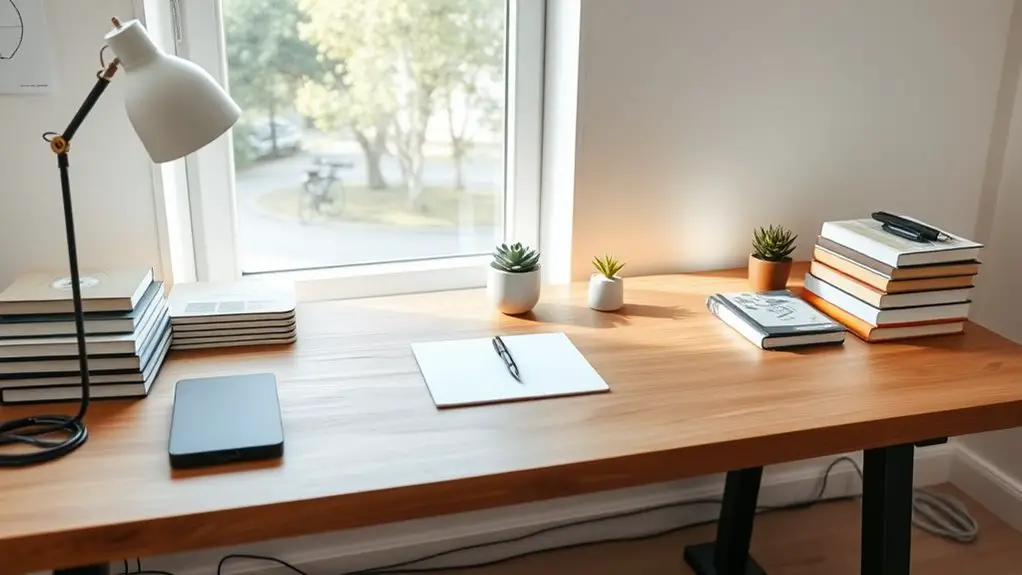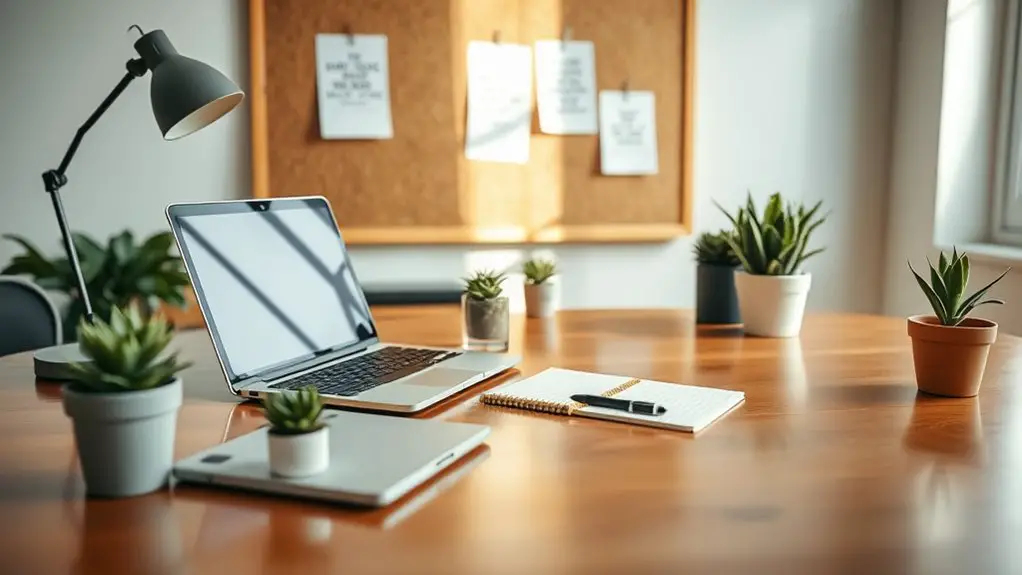To declutter your workspace, start by evaluating your space and removing unnecessary items. Sort them into Keep, Donate, Recycle, and Discard. Optimize your layout for accessibility and flow, using multi-functional furniture and designated zones. Implement smart storage solutions, like labeled bins and wall-mounted shelves, to keep things organized. Regularly maintain this order by scheduling reviews. Discover how these practices not only boost efficiency but also transform your work environment into a haven for focus and productivity.
Table of Contents
Key Takeaways
- Start by evaluating your workspace for safety and productivity, using tools like REBA and RULA to identify risk areas.
- Declutter by sorting items into Keep, Donate, Recycle, and Discard categories, focusing on areas prone to clutter.
- Implement effective storage solutions, like modular systems and wall-mounted options, to maximize space and keep essentials accessible.
- Maintain organization using the 5S method: Sort, Set, Shine, Standardize, Sustain, while involving colleagues in the process.
- Schedule regular cleaning and organizational reviews to boost morale, enhance productivity, and foster a culture of continuous improvement.
Assessing Your Workspace

Evaluating your workspace is essential for creating an environment that promotes safety and productivity. Start by using tools like REBA and RULA to assess postural and biomechanical risks associated with your tasks. Tools should work together with a set of tools for a comprehensive assessment. Combine quantitative data for detailed insights with qualitative methods for quick hazard identification. Don't forget to evaluate your workplace conditions, including workstation design and equipment usage.
Engage with your coworkers to gather feedback on their ergonomic concerns, as their insights can uncover hidden issues. Analyze the data to pinpoint high-risk areas that need improvement. Involve safety experts to guarantee a thorough assessment and develop an action plan that addresses identified risks. This proactive approach will enhance both safety and overall workplace efficiency.
Removing and Sorting Items
Start your decluttering journey by clearing everything from your workspace. This allows you to inspect what you have and identify unnecessary items. Focus on areas where clutter tends to accumulate, like your desk or corners. As you remove items, categorize them into four groups:
- Keep: Essential tools you use daily.
- Donate: Items in good condition but no longer needed.
- Recycle: Papers and materials that can be repurposed.
- Discard: Broken or outdated items that serve no purpose.
Get rid of anything that doesn't serve you, and utilize vertical space for rarely used items. A clutter-free workspace promotes a healthier atmosphere and contributes to mental clarity.
Measuring and Planning Your Layout

When measuring and planning your workspace layout, think about how to maximize space utilization while ensuring accessibility and flow. You'll want to create a layout that allows for easy movement and access to everything you need. Consider incorporating multi-functional furniture to further enhance the efficiency of your office design.
Optimal Space Utilization
To create an ideal workspace that enhances productivity, you need to measure and plan your layout effectively.
Start by optimizing how you use your space to promote efficiency and comfort. Here are four key strategies:
- Utilize IoT Sensors: Track employee usage patterns to identify underutilized areas.
- Plan Flexible Workspaces: Create adaptable layouts that cater to various work styles and tasks. This can lead to improved office space utilization, allowing for better resource management.
- Incorporate Ergonomic Design: Choose furniture and layouts that enhance comfort and collaboration.
- Implement Zone Management: Divide the office into distinct areas, like quiet zones, to support different work modes.
Accessibility and Flow
Creating an accessible workspace not only guarantees compliance with legal requirements but also enhances overall productivity and flow. Start by understanding your workspace's primary function to prioritize tool placement. Incorporate assistive technology to support employees with disabilities, ensuring clear movement pathways for seamless workflows. Use vertical space wisely to optimize desk area while adhering to ergonomic principles for comfort. Establish intuitive placements for frequently used tools, and create standardized systems for organizing files and documents. Regularly declutter to maintain clarity and reduce distractions. Engaging stakeholders in your accessibility initiatives and setting clear KPIs to track progress is essential, as measuring accessibility can significantly impact employee productivity and customer retention. By fostering an inclusive environment, you not only improve employee satisfaction but also enhance customer retention and overall business success.
Implementing Effective Storage Solutions
Effective storage solutions are essential for maintaining an organized and productive workspace.
Effective storage solutions are crucial for fostering an organized, efficient workspace.
By implementing the right systems, you can create a clutter-free environment that boosts your efficiency.
Here are four effective strategies to take into account:
- Modular Storage Systems: Customize your space with adjustable shelves and cabinets that adapt to your needs and maximize vertical space. Modular Storage Systems are versatile and customizable, making them ideal for open office environments.
- Multi-Functional Furniture: Choose desks with built-in storage to save space and provide additional utility without sacrificing style.
- Wall-Mounted Solutions: Utilize wall space for shelves, keeping essential items within easy reach while freeing up floor space.
- Mobile Storage Units: Incorporate rolling carts or portable cabinets for flexible storage that can adapt to your dynamic workspace.
These solutions can help you reclaim control over your environment!
Maintaining Organization in Your Workspace

After implementing effective storage solutions, the next step is maintaining organization in your workspace. Regularly apply the 5S method—Sort, Set, Shine, Standardize, Sustain—to keep everything efficient. Implementing systems for organization is crucial for ensuring that everyone knows their responsibilities in maintaining a tidy environment. Schedule reviews to guarantee your space aligns with your tasks and goals. Get your colleagues involved; fostering a sense of responsibility helps everyone stay organized. Don't forget about digital decluttering; routinely clean up files to avoid information overload. Embrace a culture of continuous improvement, allowing team members to suggest changes to the organization system. Conduct Gemba walks to observe workflows and identify areas for enhancement. By integrating these techniques and maintaining consistency, you'll create a workspace that supports productivity and efficiency.
Evaluating Your Productivity
To truly boost your productivity, start by identifying barriers that slow you down. Once you pinpoint these obstacles, measure how efficiently you complete your tasks. This clarity will help you make necessary adjustments and enhance your overall performance. Incorporating methods like 360 Degree Feedback can provide valuable insights into how your work habits are perceived by others, further aiding your productivity improvements.
Identify Productivity Barriers
How often do you take a moment to evaluate what's really holding back your productivity? Identifying productivity barriers is essential to creating an efficient workspace.
Here are four common culprits:
- Physical Clutter: A messy desk can distract you and increase stress.
- Digital Clutter: Unorganized files and endless notifications disrupt your workflow. Ongoing labor shortages complicate hiring and productivity maximization.
- Noise and Interruptions: High noise levels and frequent disturbances can derail your focus.
- Poor Time Management: Ineffective scheduling leads to distractions and decreased productivity.
Measure Task Efficiency
Measuring task efficiency is essential for understanding your productivity and identifying areas for improvement. Start by evaluating key metrics like task completion rate, which shows how many tasks you finish within a timeframe. Calculate your productivity rate to pinpoint high and low performers. Efficiency ratings help you evaluate focused work time versus multitasking, while tracking average task duration reveals opportunities for streamlining. It's also important to recognize that productivity measures output or performance relative to effort. Don't forget to evaluate the quality of your work, as it impacts long-term success. Utilize quantitative methods, like output/input ratios, and performance metrics software for deeper insights. Establishing KPIs like employee productivity rate and schedule adherence will also guide your efforts in enhancing overall efficiency.
Adapting Your Workspace for Efficiency
Creating an efficient workspace requires thoughtful adaptation to meet the evolving needs of your team.
By incorporating various design elements, you can enhance productivity and collaboration. Here are some key adaptations to contemplate:
- Flexible Zones: Create adaptable spaces that can easily shift between individual work and group collaboration.
- Collaboration Hubs: Designate areas specifically for team meetings and brainstorming sessions to spark creativity.
- Quiet Zones: Establish serene spaces for focused, individual work, minimizing distractions.
- Technological Integration: Guarantee strong Wi-Fi coverage and accessible charging stations to support all your tech needs. Data-driven decision-making can also be supported by ensuring that these zones facilitate easy access to relevant information and collaborative tools.
Utilizing Vertical Space for Storage
While you may have limited floor space in your office, utilizing vertical space for storage can transform your workspace into a more organized and efficient environment.
Start by installing floating shelves for books and decorative items, placing heavier items on lower shelves for stability. Wall-mounted organizers can keep important documents within reach, while narrow storage units maximize efficiency without crowding the floor. Incorporating vertical cabinets can provide significant storage while maintaining floor space.
Incorporate hooks and pegboards for hanging tools or headphones, adding both functionality and personality. Make sure to label bins and shelves for easy access, and regularly declutter to maintain an organized area. With these solutions, you'll boost productivity and enhance the overall appearance of your workspace.
Creating a Flow in Your Workspace
To create a smooth flow in your workspace, start by optimizing item placement for easy access. Clear walkways to prevent any obstructions and encourage natural movement throughout the area. This setup not only improves efficiency but also enhances your overall work experience. Additionally, implementing workflow optimization techniques can further streamline your daily tasks and reduce unnecessary distractions.
Optimize Item Placement
A well-optimized workspace can greatly boost your productivity by ensuring that every item is placed with purpose and ease of access in mind. To create a functional flow, consider these key strategies:
- Purpose-Based Placement: Keep frequently used items within easy reach to streamline your workflow.
- Task-Specific Zones: Designate areas for specific functions, reducing clutter and promoting focus. Space optimization techniques can help you identify and utilize areas that may be underused.
- Ergonomic Considerations: Arrange furniture and equipment for ideal comfort, minimizing strain during use.
- Flexibility in Design: Allow for adjustments to your layout as your needs evolve, keeping your space dynamic.
Clear Walkways Efficiently
Clear walkways are essential for maintaining an efficient workspace, as they directly impact navigation and productivity. When you keep pathways clear, you enhance navigation, saving time searching for materials or colleagues.
A well-designed walkway streamlines your workflow, allowing for efficient movement and minimizing obstructions. This boosts productivity and reduces downtime, as clear paths lead to fewer accidents or interruptions. Additionally, walkway safety measures help prevent costly disruptions and enhance overall efficiency.
Moreover, clear walkways minimize hazards, ensuring compliance with safety regulations and reducing workplace incidents. Regular inspections can help maintain these pathways, contributing to a safer environment.
An organized space not only looks professional but also fosters employee morale and reduces stress. By prioritizing clear walkways, you create a productive, safe, and inviting workspace for everyone.
Encourage Natural Movement
When you create a workspace that encourages natural movement, you not only enhance physical activity but also boost overall productivity and well-being.
Here are a few effective strategies to incorporate:
- Active Pathways: Design clear pathways that invite walking and exploration throughout your office.
- Ergonomic Layouts: Arrange furniture to facilitate movement, making it easy to interact with colleagues. Interaction among workers is a key aspect of fostering a dynamic work environment.
- Natural Elements: Integrate biophilic design with plants and natural shapes to promote calmness and creativity.
- Open Spaces: Create areas for collaboration and casual meetings, encouraging employees to get up and engage with others.
The Importance of Regular Cleaning
Regular cleaning isn't just about aesthetics; it's essential for creating a healthy and productive workspace. By regularly tidying up, you reduce germs and illnesses, ensuring a safer environment for everyone.
Regular cleaning is vital for a healthy workspace, reducing germs and fostering a safer, more productive environment for all.
A clean space enhances indoor air quality, minimizing allergens and pollutants that can affect your well-being. You'll likely notice a boost in morale and productivity, potentially increasing output by up to 12%. Additionally, cleanliness enhances employee morale and satisfaction, making it a critical component of workplace dynamics.
Furthermore, maintaining a tidy workspace reflects professionalism and can positively impact customer perception. Regular cleaning also helps in compliance with health regulations, safeguarding against potential fines.
Plus, it reduces maintenance costs and extends the lifespan of your office assets, maximizing your investment. Embrace regular cleaning—it's a simple step toward a healthier, more efficient work life.
Using Labels for Easy Access
Labels transform your workspace by making it easier to find what you need quickly. By implementing a labeling system, you'll enjoy a more organized environment that boosts your productivity. Here are a few ways to use labels effectively:
- Categorize supplies – Label bins for pens, paper, and office tools, so you know exactly where everything is.
- Color-code files – Use different colors for various projects, making it easy to spot what you need at a glance.
- Designate zones – Clearly label areas for specific tasks, like a "Creative Space" or "Admin Zone." Clear labels help identify the purpose of each zone and enhance focus.
- Track inventory – Label storage for supplies to quickly identify what's on hand and what's running low.
With labels, you'll spend less time searching and more time focusing on your work!
Continuous Improvement Strategies
To enhance your workspace effectively, implementing continuous improvement strategies is essential. Start by fostering a culture of improvement where every voice matters. Empower your team through training and open communication, encouraging innovation and adaptability. Embrace failures as learning opportunities rather than setbacks. Additionally, investing in training and development can significantly empower your employees in their continuous improvement efforts.
Here's a quick overview of effective strategies:
| Strategy | Description |
|---|---|
| Six Sigma DMAIC | Structured problem-solving approach |
| Agile Practices | Iterative development for better outcomes |
| PDCA Cycle | Regularly inspect and improve processes |
| Lean Principles | Maximize efficiency by reducing waste |
| Management 3.0 | Empower teams and promote continuous progress |
Frequently Asked Questions
How Often Should I Declutter My Workspace?
You should declutter your workspace regularly, ideally daily or weekly, depending on clutter accumulation. Schedule short sessions for effective maintenance, and adjust frequency based on how quickly items pile up. Stay organized and focused!
What Are the Benefits of Having a Clean Workspace?
Having a clean workspace boosts your productivity, reduces stress, and enhances focus. You'll feel more organized and motivated, create a professional impression, and maintain a healthier environment, all contributing to your overall well-being and efficiency.
Can I Declutter Without Removing Everything First?
You can declutter without removing everything first, but it's less effective. Evaluating items in their place can be challenging. A clean slate simplifies decision-making and helps you see what truly matters for your workspace.
What Tools Can Help Me Stay Organized Long-Term?
To stay organized long-term, you'll find tools like Asana for task management, Google Workspace for collaboration, and Trello for visualizing projects incredibly useful. These platforms streamline your workflow and keep everything in one place.
How Do I Handle Sentimental Items in My Workspace?
To handle sentimental items, you should categorize them into Keep, Donate, or Discard. Focus on memories rather than objects, and consider digitizing items to preserve them without cluttering your workspace. Regularly assess their importance.



